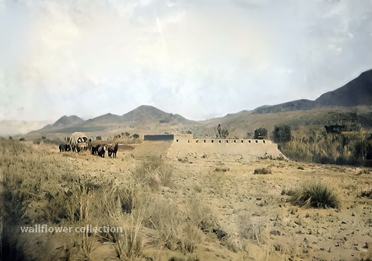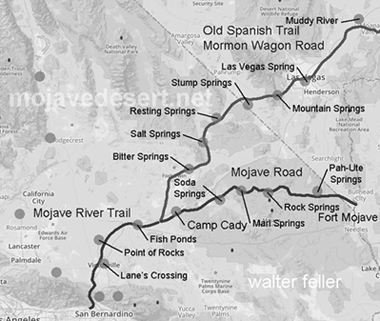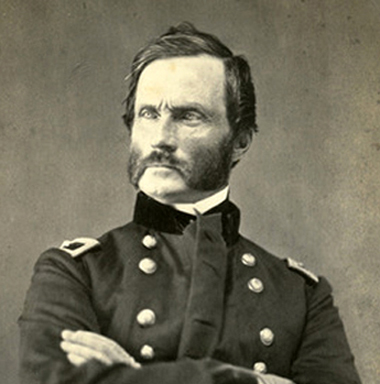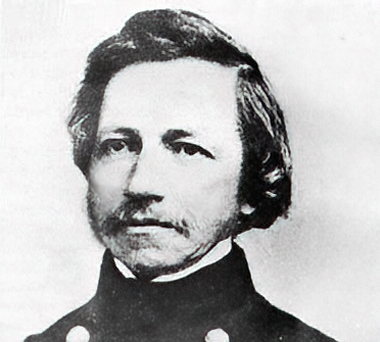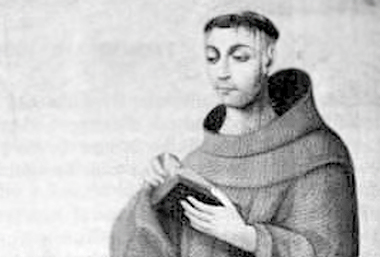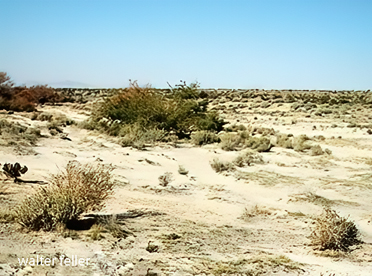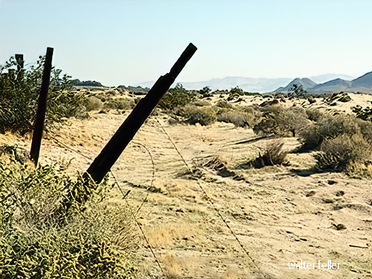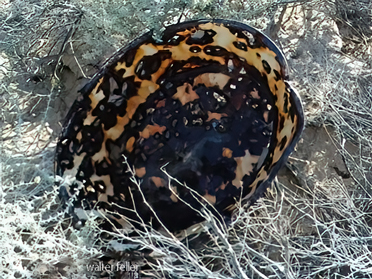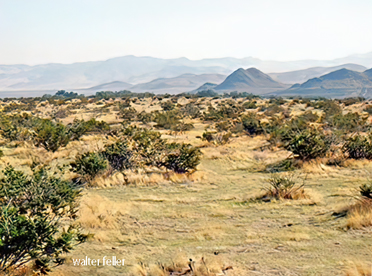Camp Cady Chronology
1776-- March.-
Father Garces set out for Mojave villages westward across the desert to go to
San Gabriel Mission. He followed the Mojave River route, passing through what years later became Camp Cady.
- Gabriel Moraga was sent into the desert area to quell Indian uprisings. Used the site of the future Camp Cady for his camping grounds.
- Jedediah S. Smith passed through the desert area using the same trail as that used by Garces.
-
Ewing Young accompanied by
Kit Carson traveled the same route and, using the same camping sites as those used by Garces, Moraga, Smith.
-
Fremont's party passed this way using much of the same route.
- Capt. Jefferson Hunt led some of the
Mormon Battalion over this trail to Salt Lake City.
- Hunt used the same route to bring the first Mormon immigrant train through to San Bernardino. Hunt also established a mail carrying service here using the future Army site as his base of operations. This he carried on for three years.
- Various surveying expeditions use the same camping ground during their expeditions to the desert. (Williamson, Whipple, Ives.)
- The site was mentioned by
Edward Fitzgerald Beale on his wagon road survey of this year. There were no soldiers here at this time, nor was there any particular need of them at this time.
- In January Edward F. Beale, accompanied by J. F. Mercer with 45 men of Company F of the First Dragoons, March to the
Colorado. This was Beale's return trip.
-
January 9, Company B and K of the First Dragoons were sent out on an expedition from
Fort Tejon to hunt for renegade Indians along the
Mojave River.
March 4. S. A. Bishop left the city of Los Angeles to go to Beale's crossing of the Colorado to cooperate with Beale on the Central Wagon Road.
September 29 (the week of). A detachment of first dragoons under Lieut. Davis accompanied by Lieut. Napier ( on service at Fort Mojave) returned to the headquarters at Fort Tejon.
October 21. Capt. Winfield Scott Hancock sent a wagon train of quartermaster supplies and equipment for the first time over the Central Wagon Road to Fort Mojave. J. Winston had charge of the train.
October 29. J. Winston with the train arrived at what he called Lieut. Davis's depot on the Mojave. This depot was on the site of Camp Cady.
- February 11. Lt. Col. B. L. Beall sent 25 men from Tejon (of the First Dragoons) to the Mojave in search of
Indians.
March 31. An extra of the Los Angeles Star for Monday morning tells of a murder on the Mojave and the need of the military post in that area.
April 11. Gen. Newman S. Clarke was petitioned to send soldiers to protect the wagon road along the Mojave River.
April 14. General Newman S. Clarke ordered Maj. Carleton with Company K of the First Dragoons, with 80 men to establish a fort near the Forks of the Road. They called it Camp Cady (after Col. Albemarle Cady). The dragoons were there for three months. They erected a temporary shelter of brush and mud. Some were even dugouts similar to those used later by miners in that region.
April 23. The letter was sent from Dr. Jonathan Letterman, who is stationed at Camp Cady with Maj. Carleton, to Gen. Hancock in Los Angeles. He tells where the different patrols are off to.
May 2. Lieut. Carr led a party in search of Indians and killed three of them near Soda Lake.
May 28. A patrol was sent out to build Hancock Redoubt at Soda Springs and Bitter Springs Redoubt some 50 miles from Camp Cady. These were to be set up as overnight camps only. The patrol consisted of Lieut. Carr and 25 men.
May 29. An express rider arrived in Los Angeles and brought news of the camp.
June 30. Maj. James Henry Carleton was ordered back to Fort Tejon.
July 3. Maj. Carleton finally left Camp Cady and was due back at Tejon on July 10.
October 17. Gen. Newman S. Clarke dies here in California and Lt. Col. B.L. Beall takes over.
-
January 29. The train of supplies was sent to Fort Mojave by way of Camp Cady, under J. Winston of the quartermaster corps.
March 4. A member of the U.S. Boundary commission gives a description of Camp Cady.
(April. Civil War)
- January-February. Beginning in early January there were floods in California. The roads around Camp Cady were in bad condition. It seems that many who later wrote about this country mention the floods of that year.
April 14. Second Lieut. Nathaniel P. Pierce of Company G of the 2nd California Cavalry Volunteers with a noncommissioned officer and nine privates arrived at Camp Cady and remained there until April 24, when they left to return to Camp Latham.
June 17 and July 7. John Brown mentions being at or near Camp Cady on these days.
- The camp does not seem to have been regularly garrisoned at this time, but was occasionally visited by Federal troops.
- July. Capt. John C. Cremony was ordered to Camp Cady with Company B of the 2nd California Cavalry. They remained there until September. The captain had just returned from the March of the California Column to New Mexico. He was to patrol wagon road from Cady to Rock Springs. From May to August 30, Company M of the 2nd California Cavalry was on an expedition covering the Salt Lake-Fort Mojave Wagon Road. Capt. George F. Price and Lieut. George D. Conrad commanded the expedition.
- Company I of the 4th Regiment of California Infantry was stationed here at the first part of the year.
March 3. Company D, first Battalion of the Native California Cavalry, was ordered to Camp Cady under Capt. Edward Bale. This company seems to have returned to Drum Barracks early in May, four on May 20 Capt. Bale resigned from the army.
April 23. The official date of the establishment of the camp.
-
Captain Walter S. Cooledge of Company C, 7th Regiment of Infantry, arrived at Fort Mojave and relieved Captain Benjamin West, who went to Camp Cady.
June 30. Captain Benjamin R. West and Company C of the 4th Infantry were still at Camp Cady when Private Kedder of Company I of the 7th Infantry passed by here on his way to Fort Mojave and Fort Whipple. Kedder told of the death by accidental shooting of Pvt. Somerindyke, who died at Cady. There was evidently no doctor there at that time.
(June. Civil War)
July-August-- Some time between July and August Captain Patrick Munday stopped at Camp Cady with his company K of the 4th Infantry. He reported 120 men at that time.
November 4. Elliot Coues visited Camp Cady. He stated that there were four officers and a handful of men there.
December 21. Three privates--Rogers, Saunders and Tierney-- were discharged a Camp Cady for disabilities.
-
January 10. General Irvin McDowell issued a special order dated Camp Cady, Jan. 11, 1866 commending Captain West for work and the work of the volunteers on putting up houses at Camp Cady.
February 9. Capt. West and his regiment were mustered out at Drum Barracks on this date.
April 21, 22. James F. Rusling made a survey of the miliary stations and was at Camp Cady on the two days mentioned.
July 29. Detachment D of the 9th Infantry engaged in a skirmish with the Indians. This detachment was supposedly under the command of a Lieut. Hartmen. One account says that f1ve soldiers were killed and one badly wounded.
-
February. Major Porter of the 14th Infantry with Mr. Hoffman and six soldiers who were on their way to report to General Meade in Philadelphia passed here and reported 43 teams on the road award t he Colorado River.
March 30. The cavalry stationed at Camp Cady have been removed to Fort Whipple. There are 15 at Cady under Lieut. John Drum
June 1. Lieut Eyre of the 14th Infantry had just arrived at Drum Barracks with recruits for the desert posts.
June. Lieut. Manuel Eyre Jr. replaced Lieut. Drum at Camp Cady. Lieut. Drum goes to Rock Springs.
June 24. Two soldiers and an expressman from Camp Cady engaged in a fight with Indians at Marl Springs about 70 miles from Camp Cady.
July 6. Another Indian fight between Rock Springs and Pah Ute Springs.
August 3. Teaming on the Mojave continues brisk. Mr. Matthews is the contractor at Camp Cady.
August 8. A store belonging to P. N. Dean was burned by soldier stationed at Cady under the command of Lt. Eyre.
August 31. Lieut. Manuel Eyre offers 200 sheep for sale at Camp Cady.
November 2. The Indians who killed Dr. Shaw near the caves are prowling near Camp Cady and Rock Springs.
December 14. The teams coming from Camp Cady had trouble getting to San Bernardino because of the mud on the mountain roads.
-
June. Mr. Dean sued Eyre for the loss of his property and his business.
October 6. Old site abandoned. New site selected one~half mile west of old camp.
Fall. Permanent buildings were erected at Cady under Lieut. John Drum.
December. Another wagon train left from Los Angeles for Camp Cady.
-
May 18. Lieut. Manuel Eyre was dismissed from the army.
-
October 19. General Stoneman in General Orders No. 19 officially declared Camp Cady a Military Reservation.
-
March. The camp was abandoned and was turned over to Mr. Cantwell and Mr. Winters, stockmen on the
Mojave River. 2nd Lieut. James Halloran of the 12th Infantry supervised the sale of the property.
-
August 21. 19,000 pounds of machinery arrived at Camp Cady to be set up as the Alvord Mill.
-
1n General Orders No. 30, as of July 5, 1884, President Arthur declares the Camp useless for Mi1itary purposes and orders it disposed of.
-
March. The last vestiges of Camp Cady washed away by a flood.
from: Horse Soldier Forts of the Mojave Desert by Leonard Waitman
